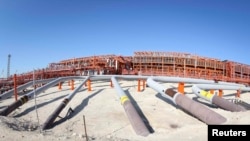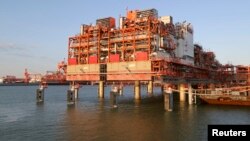
Production at Kazakhstan's enormous Kashagan oil and natural-gas field has started again. Already more than a decade behind schedule, and billions of dollars overbudget, the project once seen as Kazakhstan's ticket to El Dorado is now just hoping to alleviate some of the economic pain the country is experiencing and break even before too many more years pass.
Kazakh Energy Minister Kanat Bozumbaev announced on October 12 that the flow of oil from the Caspian Sea field had reached a total of 90,000 barrels per day, from four wells. Bozumbaev added that the Bolashak oil refinery was already receiving oil from the field and shareholders in the project would be announcing the first contracts in coming days.
Bozumbaev said commercial flows of oil were expected by the end of this month.
While that is good news, there are probably more than a few people who still have their fingers crossed hoping nothing else goes wrong at Kashagan, which has proven to be something of a cursed project.
Kashagan started production in September 2013, about eight years behind schedule, but was quickly shut down when leaks were detected in the pipelines running from the site, some 90 kilometers off Kazakhstan's coast, to the mainland.
Initial efforts to correct the problem proved futile as it became apparent that toxic gas in the pipeline had corroded the pipelines, necessitating the total replacement of both pipelines with more expensive nickel-based alloy pipes.
In the wake of the failure, Pierre Oliphant, the managing director of the North Caspian Operating Company (NCOC), resigned. Kazakhstan's government made clear that the consortium was responsible for the cost of replacing the pipelines.
State oil and gas company KazMunaiGaz quickly shed its 16.81 percent stake in the consortium, giving half of it to a subsidiary, KMG Kashagan BV, and the other half to Kazakhstan's Samruk-Kazyna sovereign wealth fund.
Losses from the three-year delay in production at Kashagan are estimated to run into the billions of dollars. That could be added to the cost overruns already incurred. The project was originally expected to cost some $38 billion but that figure has shot up to at least $53 billion, and according to some estimates, could eventually be more than $100 billion.
Kashagan is the biggest oil discovery since Prudhoe Bay in Alaska in 1968 and Russia's Priobskoye North field in 1982. Kashagan is believed to contain 13 billion barrels of recoverable crude oil. The NCOC says there could be as much as 38 billion barrels of oil there, and further exploration and improved technology could add to the current figure for recoverable oil.
Kashagan is also estimated to contain some 1 trillion cubic meters of natural gas.
Italy's Eni, the NCOC partner currently managing Kashagan, says oil production should reach some 230,000 barrels per day (bpd) by the end of 2016 and rise to some 370,000 bpd by mid-2017.
However, in September the Bloomberg news agency quoted Samuel Lussac, research manager in Russia for the U.K. consulting firm Wood Mackenzie, as saying, "We don't expect Kashagan Phase 1 to produce more than 300,000 bpd until the early 2020s."
Even if Kashagan reaches more optimistic production forecasts, many analysts believe the project has already missed its prime window of opportunity. With oil prices at less than half what they were just a few years ago, there is speculation Kashagan may no longer be profitable.
However, 17 years into the project the consortium has no choice but to go ahead, if for no other reason than to recoup the investment already made.
Kazakhstan's government, on the other hand, is assured of seeing some profit from the project, though again, not the large amounts Astana was counting on seeing just a few years back.
The NCOC is made up of Agip Caspian Sea, U.S. company ExxonMobil, France's Total EP, and Royal Dutch Shell, each with 16.81 percent stakes; KMG Kashagan and Samruk Kazyna with 8.4 percent each; the China National Petroleum Corporation with 8.33 percent; and Japan's Inpex with 7.56 percent.







